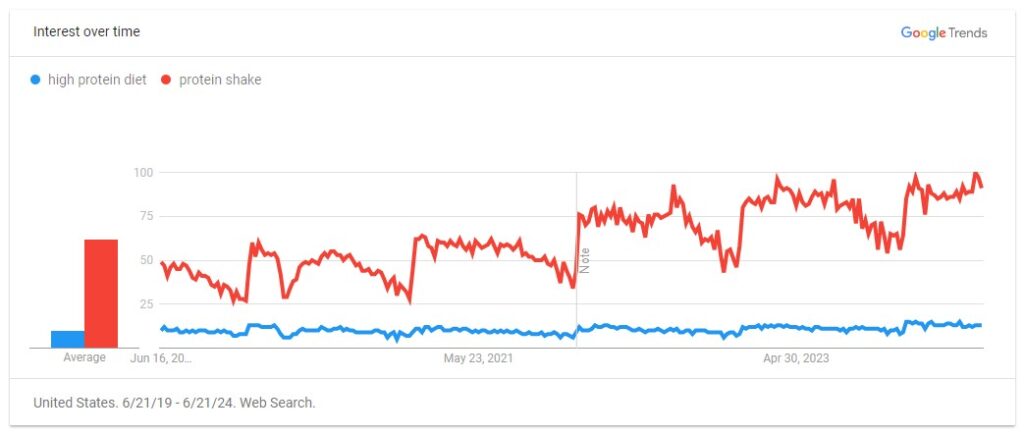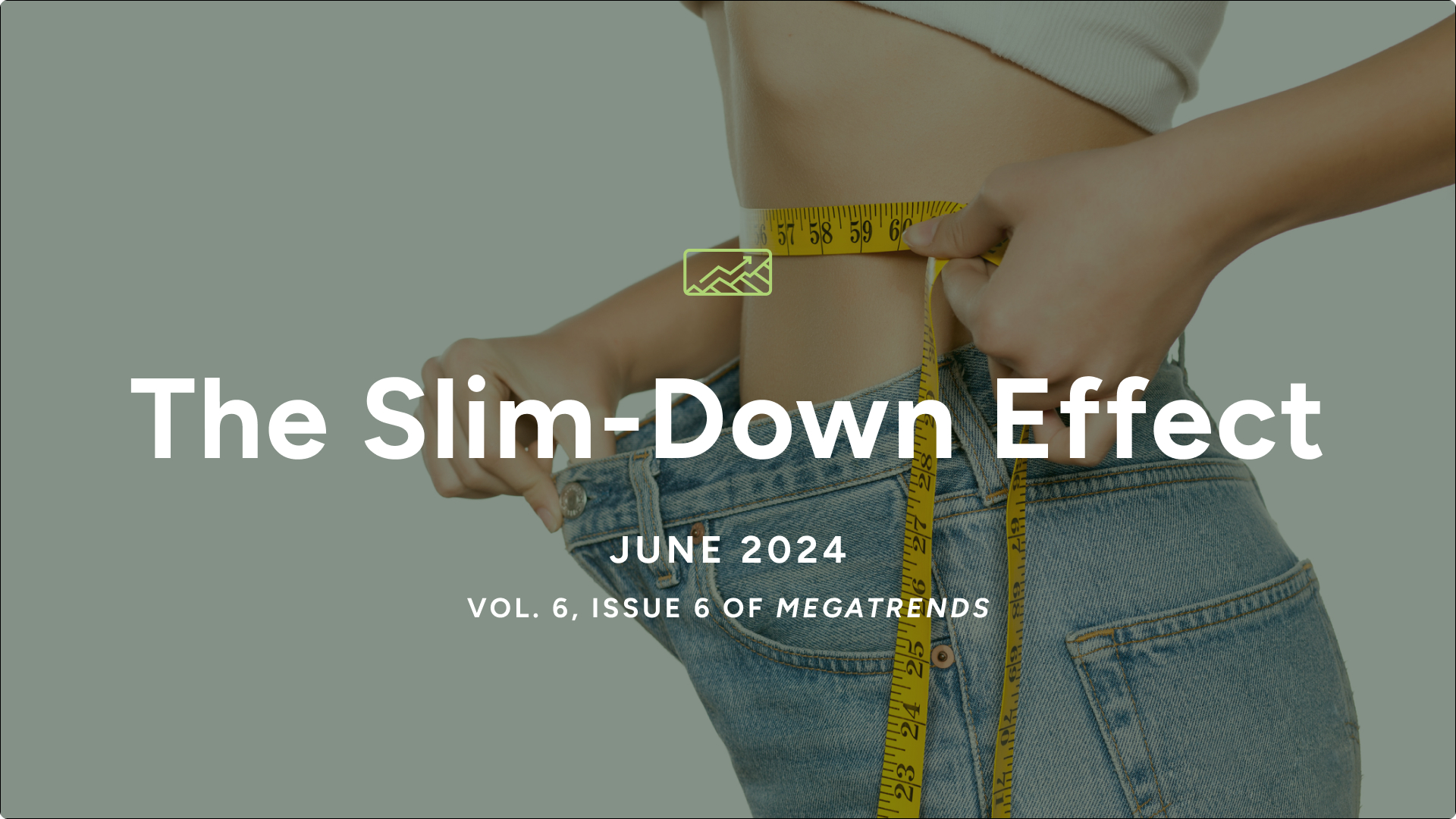“Skinny shots” are here to stay, and the opportunity for investors is much larger than even we expected.
By “skinny shots,” I mean the GLP-1 drugs used for managing diabetes and obesity, better known under brand names like Ozempic and Wegovy.
These drugs are on track to become the best-selling drug type by the end of 2024.
By 2030, GLP-1 drugs could be a $100 billion global market. Analysts at Goldman Sachs Research and JPMorgan agree.
Heck, JPMorgan estimates a whopping 30 million Americans – about 9% of the U.S. population – could be on these medications by then.
Within the first five years of its GLP-1 drugs being on the market, Novo Nordisk (NVO) saw its market value quadruple, turning it into the single most valuable European company by market cap.
We’ve kept our followers ahead of this weight-loss mega trend with our direct line to Main Street.
We saw consumers talking about taking these weight-loss drugs at unprecedented levels in 2023. And our Social Heat Score led us to some massive wins as stocks soared on that demand, including 174% on WW International (WW) and 69% on Hims & Hers Health (HIMS).
But that was just the tip of the iceberg…
Ripple Effects of “The Ozempic Lifestyle”
Weight-loss drug prescriptions are flooding in like (increasingly trim) fans into a stadium on game day, swiftly and in large numbers.
Consumer interest in these drugs is escalating to new heights in 2024 with no signs of slowing down:

These drugs are leading to meaningful weight loss for huge swaths of the population. Studies reveal average weight losses between 15% to 21% of total body weight after just a over a year on the injectable medication.
And that’s likely to trigger major second-level changes in behavior, from trading in Oreos for apples, to spending more time in a gym.
One survey revealed that the weekly exercise rate among participants doubled from 35% before starting anti-obesity medications to 71% afterwards. This increase in physical activity was attributed to the enhanced physical capability and mental motivation experienced by patients as they started losing weight due to the medications.
The takeaway: Weight-loss medications not only directly impact weight, but also positively influence patients’ lifestyle choices.
In other words, when it comes to investing, it’s not just about the drugmakers themselves or the telehealth providers prescribing them.
You can also cash in on the behavioral changes stemming from the millions of consumers who plan to or have already started their weight-loss journeys.
Let me show you a few unexpected ways we can play this trend for profits…
No. 1: Slimmed-Down Apparel
Retailers are discovering that significant weight loss among consumers is boosting sales as people switch to smaller clothing sizes.
For example, Rent the Runway (RENT) has reported the biggest move to smaller sizes in the past 15 years. This trend is not just about replacing old wardrobes, but also about adopting more body-hugging and risqué designs.
Brands are responding by incorporating adjustable corsets and sheer looks to accommodate this shift.
One high-end fashion brand noted that about 5% of its customers are buying new outfits due to weight loss, often replacing size 12 clothes with size 6 or 8. This not only boosts sales, but also reduces costs as smaller sizes use less fabric.
Similarly, Amarra, a formal wear company, has seen increased demand for smaller sizes, prompting design changes to include lace-up corsets and sheer panels.
Near-term weakness in the apparel sector due to rampant inflation is likely to create ideal entry opportunities in the coming weeks and months. That’s why we made it the focus of the June MegaTrends Report that hit member inboxes yesterday…
In this month’s issue, we gave members an exclusive look at three apparel companies that stand to benefit from increased adoption of these weight-loss drugs over the next five years. One of those stocks, trading at just $2 a share, looks like an ideal moonshot play already.
You can learn how to unlock the full issue with all the details right here. 🔒
No. 2: Powered-up Protein
As weight-loss drugs like Ozempic grow in popularity, so does consumers’ interest in grabbing on-the-go, protein-packed, nutritious food.

See, GLP-1 drugs slow down how quickly the stomach empties after eating, making you feel full for longer, and essentially reducing your appetite.
When you cut your calories that much while burning fat and muscle, you need to supplement with protein, and ready-to-drink (RTD) protein shakes are a great way to do that.
Companies catering to individuals seeking nutritious and convenient protein-packed options for maintaining an active lifestyle could see a ramp-up in demand.
We’ve identified one company that’s become a staple of the “Ozempic Lifestyle.” Its RTD protein shakes are the clear favorite on Main Street, boasting a sky-high Consumer Happiness score of 86%.
MegaTrends members can learn more about this hidden gem in today’s Video Bulletin as the stock verges on a breakout. (Non-members can click here to learn how to join for immediate access.)
We’re also keeping a close eye on a “protein coffee” trend that’s gaining in popularity. Certain coffee chains are now offering protein coffee options that cater directly to these consumers, and LikeFolio is tracking significant buzz around one ticker in particular that recently joined the MegaTrends model portfolio.
I’ll point you to another related play that could similarly benefit…
No. 3: More Caffeine, Please
Did you know that consumers who use a GLP-1 drug are 72% more likely to consume an energy drink compared to the general population?
This translates to 86% of GLP-1 users reaching for an energy drink at least once.
The increased consumption of caffeine among consumers on weight-loss drugs like GLP-1s might be attributed to the drugs’ appetite-suppressing effects.
As these drugs reduce calorie intake, consumers may turn to caffeine as an alternative energy source. This compensates for the energy deficit caused by the lower calorie consumption.
Celsius Holdings (CELH), which makes better-for-you energy drinks marketed to health and wellness enthusiasts, is a top stock to watch for “The Ozempic Lifestyle.”
It’s one of LikeFolio’s biggest winners to date. And as CELH resonates with consumers more than ever, its stock has room to run.
The Bottom Line
The weight-loss drug mega trend is much more than a passing fad. And its impacts extend far beyond health benefits, as you saw here today.
As weight loss triggers major second-level changes in behavior, from healthier habits to needing new, better-fitting clothing to accommodate smaller sizes, investors have no shortage of opportunities to profit.
Until next time,

Andy Swan
Founder, LikeFolio
P.S. If you’d like to learn more about the next-level Ozempic plays we discussed today, you can get started here. We’d love to have you join us at MegaTrends.
Discover More Free Insights from Derby City Daily
Here’s what you may have missed…
With Reels, TikTok’s Loss Is META’s Gain
This social media star is driving massive growth with its answer to TikTok…
Uncle Sam Wants a Piece of DraftKings’ Billion-Dollar Pie
Tax hikes threaten to thwart online sports betting growth – but it won’t be the death of DKNG…



